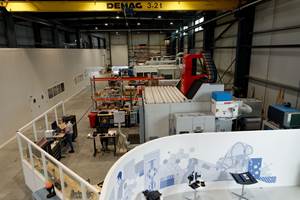Cooperating on new-generation ground transport
CompositesWorld's editor-in-chief Jeff Sloan shares his observations about the mixture of excitement and anxiety about the future of composite in the auto industry on display at the recent Thermoplastics Composites Conference for Automotive (TCCA), held in the Detroit suburb of Novi, MI, US.
We composites professionals look at the automotive market with a unique combination of excitement and anxiety. The excitement grows out of the knowledge that the auto industry has a mandate to lose weight, and composites are an obvious choice to help get that done.
The anxiety grows out of uncertainty: What materials will be used — composites? Aluminum? New light steel? How and where will they be applied? Which OEMs will apply them? How will composites fit into the automotive supply chain?
And, frankly, we should chalk up some of our anxiety to the old adage, “Be careful what you wish for.” That is, depending on how composites are applied in the automotive market, some suppliers and fabricators might struggle to meet what could be substantial and unrelenting demand for composite materials and parts.
There is some irony in this. The composites industry has coveted mainstream automotive applications for so long that it seems to me we are like the persistent, pesky salesman, talking up his products’ litany of benefits as he shops his wares to automotive OEMs around the world, trying to get his foot in the door and prove they can do the job.
But this is an unfair analogy. It’s not fair to the composites indus-try or to automotive OEMs. The truth is that composites will not be sold into an automotive program. Composites will earn their way into automotive programs, and only because they meet a specific structural or aesthetic need cost-effectively.
I was reminded of this forcefully this week (it’s June 17 as I write this) at CompositesWorld’s Thermoplastics Composites Conference for Automotive (TCCA), in the Detroit suburb of Novi, MI, US. I was a conference co-chair, along with Matt Naitove, executive editor, and Lilli Sherman, senior editor, of sister publication Plastics Technology. The conference attracted almost 200 attendees from across the automotive supply chain, who came to see and hear 21 presentations on a variety of material and process tech- nologies aimed at thermoplastic composites for the auto industry. Presentations ranged from the latest on long glass fiber-reinforced thermoplastics to carbon fiber use in compression molding to simulation of chopped fiber orientation in injection molding.
What struck me over the day-and-a-half conference was the variety and quality of the material and process innovation presented, and the intensity of the presenters. These were not salespeople trying to talk a reluctant automotive industry into buying a product. They were technology and material specialists who have listened carefully to what automotive OEMs say they need, and have developed carefully crafted solutions to meet that need.
Some solutions are mature, well-developed and in use today. Others are clearly still in development. All of them, though, are highly targeted and designed to leverage the multi-fiber, multi-resin, multi-process dynamism of the composites industry. Covestro LLC, for instance, announced at the conference that it has begun working on application of fiber-reinforced polycarbonate for the fabrication of Class A automotive body panels. Teijin reported on the status of its compression-molded chopped carbon fiber/polyamide composite material for structural vehicle parts. Sigmatex informed attendees about its efforts to incorporate recycled carbon fiber and thermo- plastic fibers into its reinforcements product line. The Fraunhofer Institute for Chemical Technology (ICT) reported on its work developing sandwich structures with tailored, foam-injected cores. And Autodesk revealed details of its research into simulating weld line behavior in injection molding.
I will report on all of the conference presentations in next month’s CW, but suffice it to say that I was strongly impressed by the creativity, intelligence and forethought represented throughout the conference — on the podium and in the audience.
Ultimately, my takeaway message was this: Material and process specialists throughout the automotive and composites supply chain are working cooperatively and collaboratively to drive weight out of vehicles, increase fuel efficiency, build in sustainability and usher in a new generation of vehicles that promises to reshape transportation. And that’s as good a thing to wish for as I could hope.
Related Content
JEC World 2023 highlights: Recyclable resins, renewable energy solutions, award-winning automotive
CW technical editor Hannah Mason recaps some of the technology on display at JEC World, including natural, bio-based or recyclable materials solutions, innovative automotive and renewable energy components and more.
Read MoreHexagon Purus Westminster: Experience, growth, new developments in hydrogen storage
Hexagon Purus scales production of Type 4 composite tanks, discusses growth, recyclability, sensors and carbon fiber supply and sustainability.
Read MoreNatural fiber composites: Growing to fit sustainability needs
Led by global and industry-wide sustainability goals, commercial interest in flax and hemp fiber-reinforced composites grows into higher-performance, higher-volume applications.
Read MorePlant tour: Daher Shap’in TechCenter and composites production plant, Saint-Aignan-de-Grandlieu, France
Co-located R&D and production advance OOA thermosets, thermoplastics, welding, recycling and digital technologies for faster processing and certification of lighter, more sustainable composites.
Read MoreRead Next
Developing bonded composite repair for ships, offshore units
Bureau Veritas and industry partners issue guidelines and pave the way for certification via StrengthBond Offshore project.
Read MoreAll-recycled, needle-punched nonwoven CFRP slashes carbon footprint of Formula 2 seat
Dallara and Tenowo collaborate to produce a race-ready Formula 2 seat using recycled carbon fiber, reducing CO2 emissions by 97.5% compared to virgin materials.
Read MoreVIDEO: High-volume processing for fiberglass components
Cannon Ergos, a company specializing in high-ton presses and equipment for composites fabrication and plastics processing, displayed automotive and industrial components at CAMX 2024.
Read More



















